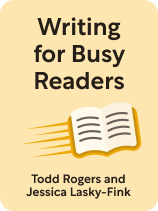

This article is an excerpt from the Shortform book guide to "Writing for Busy Readers" by Todd Rogers and Jessica Lasky-Fink. Shortform has the world's best summaries and analyses of books you should be reading.
Like this article? Sign up for a free trial here.
Do you want to know how to spread a message with your writing? What factors do you need to consider?
Part of an effective writing strategy is knowing how to spread a message. You need to consider who the spokesperson will be, what medium you’ll use, when you’ll share your content, and how to follow up with your audience.
Continue reading for advice from behavioral scientists Todd Rogers and Jessica Lasky-Fink.
Spreading Your Message
When you’re satisfied with your product, it’s time to disseminate your message. But before you press “send” or “publish,” Rogers and Lasky-Fink recommend that you put some thought into how you’ll spread your message. More specifically, they recommend considering your spokesperson, medium, timing, and follow-up strategy.
Who’s Your Spokesperson?
Most of the time, you are your own spokesperson—for example, in your role as a supervisor, you likely send emails directly to your staff. But Rogers and Lasky-Fink explain that if you’re writing on behalf of an organization or collective, you might be able to choose a spokesperson other than yourself. If so, choose one who resonates with your audience and aligns with the message’s purpose. To select the right spokesperson, you must know your audience well; different speakers will appeal to different readers. For example, elderly readers may prefer to hear from people in their age range over younger sources.
(Shortform note: If you’re writing on behalf of an organization or collective, experts recommend building a pool of multiple spokespeople. Different team members will have different expertise, communication styles, and levels of relatability for various audiences. By having a range of voices to choose from, you can match the right spokesperson to the specific message and audience—improving credibility, trust, and engagement. Experts also recommend giving the team members you ask to serve as spokespeople room to say no. If their heart’s not in it, the message may come across as inauthentic or forced, which could hurt rather than help your communication goals.)
What Medium Will You Use?
As a general rule, the authors recommend that you ask your audience how they’d prefer you communicate with them whenever possible. In our increasingly digital world, many writers assume that digital communications like texts and emails are the best way to reach people. But that’s not always the case—paper communications may better capture readers’ attention because they’re less common. Additionally, it’s important to keep in mind that not everyone can easily access technology. For example, it may be better to print out (rather than email) surgical aftercare instructions, so there’s no chance a patient won’t have access to them.
| How to Choose the Right Medium In addition to asking your audience which mediums they prefer, communication experts say you should consider these factors when choosing a medium: – Urgency: Some mediums are more appropriate when time is of the essence. For example, if a message needs immediate attention, a phone call or text may be more effective than email or printed mail, which might not be seen right away. – Formality and tone: The medium can shape how formal or serious your message feels. A letter or formal email may lend more weight to a message than a casual Slack message, which could influence how it’s received and acted upon. – Interactivity: Digital platforms can allow for quicker, easier two-way communication. If you need to gather input, answer questions, or clarify points, digital media may foster more engagement than static formats like flyers. – Privacy and security: Some messages contain sensitive information (e.g. medical or financial details) and should be shared through secure, private channels. Choosing the right medium can help protect both the sender and the recipient. – Retention and reference: If you want recipients to refer back to the message later—like instructions or schedules—it might make sense to use a format that’s easy to save and revisit, such as a printed document, a PDF, or an intranet post, depending on audience preferences. |
When Will You Share Your Content?
Ideally, you want your content to reach readers at a time when they’re free to engage with it. The optimal time to share content will vary depending on who your audience is, so it’s important to know your audience and anticipate their schedules. For example, if you’re writing to busy moms, it’s probably best to avoid sending a mass text during school pick-up or drop-off times. Rogers and Lasky-Fink also recommend timing your message so readers have enough time to act on your CTA. However, you don’t want to send it out too early, or you risk your readers forgetting about it.
(Shortform note: Timing your message appropriately doesn’t just require anticipating your audience’s schedules; it also requires anticipating their emotional states. For example, sending a complex or emotionally charged message at the end of a long workday may result in lower comprehension or even negative reactions. People tend to have more cognitive bandwidth and emotional patience from mid-morning to early afternoon and after breaks. By aligning your message with moments when your audience is likely to be more mentally and emotionally receptive, you increase the chances that it’ll be received thoughtfully and acted upon.)
How Will You Follow Up?
After you disseminate what you’ve written, you may want to follow up with your audience—especially if you’re asking them to take a particular action. Reminders can be effective, but Rogers and Lasky-Fink warn against sending too many. Excessive follow-ups overwhelm your audience—you likely know this firsthand if you’ve ever unsubscribed from, muted, or even blocked a sender who bombarded you with messages. If you choose to follow up multiple times, consider switching up your approach to keep readers’ attention. For example, as the deadline for taking action approaches, adopt a more urgent tone and use more compelling language.
(Shortform note: Psychological research suggests people are more likely to act when they feel in control. So, write follow-ups that are supportive, not pressuring—for example, “Just a quick check-in in case this slipped through the cracks” is better than “Final reminder before you miss out.” This respects the reader’s autonomy and avoids triggering resistance. Save an urgent tone and compelling language for cases when you need to assert your authority—for example, when you’ve already asked an employee to complete a task multiple times and the deadline is swiftly approaching.)

———End of Preview———
Like what you just read? Read the rest of the world's best book summary and analysis of Todd Rogers and Jessica Lasky-Fink's "Writing for Busy Readers" at Shortform.
Here's what you'll find in our full Writing for Busy Readers summary:
- Why some writers are so successful at connecting with readers while others aren't
- How to make your writing more impactful and increase your reach
- That how you communicate can be just as important as what you say






